2014 NAI Central Report
Reporting | SEP 2013 – DEC 2014
-
Introduction
Beyond administering awards to its teams, NAI Central pursues a broad mission to cultivate an active astrobiology community by carrying out, supporting, and catalyzing collaborative, interdisciplinary research; training the next generation of astrobiology researchers; providing scientific and technical leadership on astrobiology investigations for current and future space missions; exploring new approaches to using modern information technology to conduct interdisciplinary and collaborative research among widely-distributed investigators; and supporting learners of all ages by implementing formal, informal, and higher education programming and public outreach.
In concert with the NAI’s 12 teams, NAI Central plays an active role in engaging the astrobiology community by managing or contributing to a portfolio of programs that offer opportunities for the ongoing exchange of ideas, new interdisciplinary research, collaborative field expeditions, training in astrobiology and public education. The result is an integrated, collaborative community of astrobiologists that advances our understanding of the origins, evolution, distribution, and future of life in the Universe.
Training Astrobiologists and Supporting Early-Career Investigators

AbGradCon attendees listening to a presentation at Rensselaer Polytechnic InstituteAbGradCon:
The Astrobiology Graduate Conference (AbGradCon) provides a unique setting for astrobiology graduate students and early career researchers to come together to share their research, collaborate, and network with their peers. The Rensselaer Polytechnic Institute team hosted the 2014 Astrobiology Graduate Conference (AbGradCon) in Troy, New York from July 27-31, including 66 US-based and 4 international graduate students. This was the 10th year of the conference, and the meeting drew over 150 participants, both locally and online, through presentations, poster competitions and public outreach events, a pub night with astrobiology trivia and a regional heat of FameLab, “Exploring Earth and Beyond”. AbGradCon is organized entirely by graduate students and postdocs; the NASA Astrobiology Institute provides funding for the conference and webcasting support.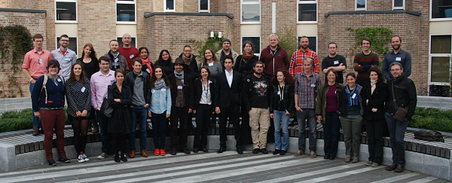
Participants and keynote lecturers of the first AbGradE symposium in 2014. Photo courtesy AbGradE, Baptiste JournauxAbGradE:
Modeled after AbGradCon, Astrobiology Graduates in Europe (AbGradE) held its inaugural conference in October, 2014 in Edinburgh prior to the annual European Astrobiology Network Association (EANA) meeting in October. NAI Central staff met with the organizers and provided printed materials to share at the meeting. It is hoped that a joint AbGradCon and AbGradE event can be organized in the coming years.NASA Postdoctoral Program:
The NASA Astrobiology Program received a total of 43 proposals from the NASA Postdoctoral Program (NPP) in March and November of 2014. The nine selected postdoctoral fellows and their research topics can be found at https://astrobiology.nasa.gov/nai/funding/nasa-astrobiology-postdoctoral-fellowship-program. During this period, over 120 astrobiology research-related opportunities from the NASA Astrobiology Program were managed through the NPP and ten fellows found employment – nine as assistant or visiting faculty and one as a NASA employee.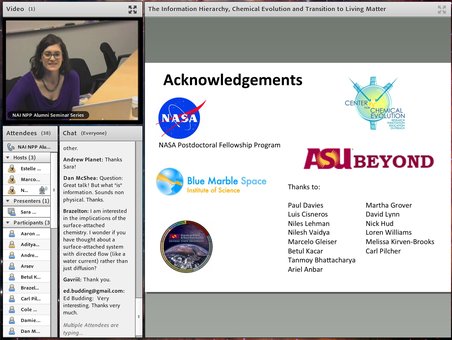
Sara Walker giving a NPP Seminar from Arizona State UniversityNASA Postdoctoral Program Astrobiology Seminars:
The NASA Postdoctoral Program (NPP) Astrobiology Seminar series are produced virtually by NAI and provide an opportunity for early career astrobiologists to share their work with one another and with the astrobiology community at large, typically following the conclusion of an NPP fellowship. This past year, eight presentations were given to an average audience of 30-50 people.Early Career Collaboration Awards:
The Astrobiology Early Career Collaboration Award offers research-related travel support for undergraduate, graduate students, postdoctoral fellows and junior scientists. During this reporting period, NAI solicited, evaluated and selected proposals and funded 14 early career astrobiologists to travel to laboratories and research facilities through the Early Career Collaborations. The awards included collaborations such as gaining access to Mars Simulation Chambers, sampling and characterizing of Serpentinite-hosted shallow-sea hydrothermal vents, analysis of zircon geochemistry and high resolution spectroscopy of exoplanet host stars.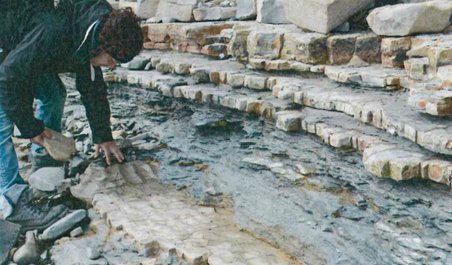
Triassic-Jurassic Boundary beds of Lavernock Point South Wales. Photo credit: Sarah GreeneLewis and Clark:
The Lewis and Clark Fund for Exploration and Field Research in Astrobiology is a program supported jointly by the NAI and the American Philosophical Society. Each year graduate students, postdocs, and early-career scientists propose field trips to engage in field studies in astrobiology. NAI Central advertises the opportunity, identifies reviewers, participates in selection and posts reports of the Lewis and Clark Scholars. In 2014 NAI received 22 applications to travel to sites from Mount Rainier to Mongolia. The nine selected proposals and reports can be found at https://astrobiology.nasa.gov/nai/funding/lewis-and-clark-fund-exploration-and-field-research-astrobiology/
The Research Focus Group winning proposal teamResearch Focus Group Workshop:
Organized by and for early career scientists, this intensive training workshop brings together early-career astrobiologists from diverse academic backgrounds for an intensive three-day collaborative proposal writing experience. The central objective of workshop participants is to create an original proposal on a topic relevant to the current state of astrobiology research, which must be presented to a body of peers. The 2014 Research Focus Group Workshop was held in conjunction with AbGradCon at Rensselaer Polytechnic Institute’s Darrin Freshwater Institute in Lake George, New York with 18 US-based and two international participants and was funded by NAI. The winning proposal was entitled, “Characterizing the Biomechanisms used by Klebsormidium sp. to Survive in Extreme Cold: Applications to the Habitability of Mars and Europa”.Support for SAGANet:
SAGANet is a grassroots, community-led social media network for astrobiology. Over the past year, this online community has almost tripled in size to over 1000 users, has started their own collection of seminar series, book clubs and a comprehensive mentorship program. The NAI has provided seed support to the organizers to expand their mentoring services and for equipment and operational expenses.Summer/Winter Schools:

Participants in the UHNAI‐Nordic Winter School 2014Nordic Winter School: The NAI provided partial support for the US-based students and instructors participating in the January 2014 NASA Nordic Winter School. The 30 students, 10 men and 20 women from 8 countries, participated in lectures, discussion, hands on activities and presentations. The students spent 23 hours in the field which included an opportunity to plan observations using the UH 2.2m telescope on Mauna Kea and to work with data from these facilities.
Microbial Diversity Summer Course: The NAI provided support to the US-based students selected for the Marine Biological Laboratory’s Microbial Diversity Summer Course, which was held in Woods Hole MA, from July 7th through August 20th, 2014. Of the 20 students, 16 were PhD students, 3 were post-doctoral associates; and 1 had a PI research appointment (NASA). The focus of this course is to train participants to discover, cultivate, and isolate microorganisms representing a broad swath of physiotypes from diverse natural and engineered ecosystems.
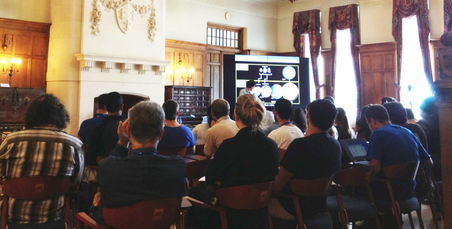
Lecture at Santander Summer School 2014Santander: The 2014 International Summer School in Astrobiology was held at the summer campus of the Spanish National University (UIMP), Santander, Spain on June 23-27, 2014. The course was organized together with the Centro de Astrobiología, NAI’s Spanish international partner, and was Co-directed for the NAI by VPL PI Vikki Meadows. This past year’s theme was “Habitable Environments in the Universe.” The course provided an interdisciplinary examination of the nature and evaluation of habitability, an environment’s ability to support life. The lecturers included Prof. Rory Barnes (University of Washington), Dr. Tori Hoehler (NASA Ames). Prof. Olivier Grasset (Université de Nantes) and Dr. Ricardo Amils (Centro de Astrobiologia). Participation in the course was very competitive, with 23 Summer School Scholars selected to attend from U.S. universities. The course program and lecture charts can be viewed at: https://astrobiology.nasa.gov/nai/uimp/2014-santander-summer-school-program/
Integrating the Community
Assessment and Recommendations of Collaborative Practices at NAI:
NASA Postdoctoral Program Fellow Dr. Arsev Umur Aydınoğlu completed his tenure at NAI Central this past year and reported his results in a number of significant publications. Dr. Aydınoğlu’s objective was to study NAI’s current collaborative practices and provide insight and recommendations for their evolution and improvement, particularly with respect to remote communication, data sharing and analysis across distance, collaborative problem solving, interdisciplinary science, and institutional identity. For more information see:Taskin, Z. & Aydinoglu, A.U. (2015). Collaborative multidisciplinary astrobiology research: A bibliometric study of the NASA Astrobiology Institute. Scientometrics, doi: 10.1007/s11192-015-1576-8 http://link.springer.com/article/10.1007%2Fs11192-015-1576-8
Aydinoglu, A.U., Suomela, T., Malone, J. (2014). Data management in astrobiology: Challenges and opportunities for an interdisciplinary community. Astrobiology, 14(6), 451-461. doi:10.1089/ast.2013.1127 http://online.liebertpub.com/doi/abs/10.1089/ast.2013.1127

Barbara Sherwood Lollar presenting at the NAI Director’s Seminar from the University of Toronto in November 2013NAI Director’s Seminars:
The NAI Director’s Seminar Series is an invitation-based, virtual lecture series of notable leaders in the astrobiology community. Participants can join seminars over a wide range of avenues, including videoconferencing, Adobe Connect and telephone. During the reporting period, NAI planned and produced nine seminars were produced with an average audience of 50-60 participants each. Recordings of all the seminars are available here.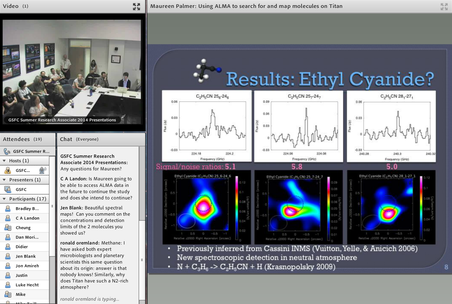
Presentations from the 2014 GSFC Summer Research Associates ProgramAstrobiology Seminars:
The NAI supports a number of other virtual seminar series, including the VPL Astrobiology Colloquium Series, the Goddard Space Flight Center Summer Research Associate Seminar Series, and other conferences and workshops. Over the reporting period, 18 VPL Colloquiums were produced and three major conferences were webcast, including the Thermodynamics, Disequilibrium & Evolution Workshop, the Habitability of Icy Worlds Workshop and EBI: Search for Life Beyond the Solar System Conference. Recordings of all of these event are available at https://astrobiology.nasa.gov/seminars/.Conference Sessions and Travel Support:
The NAI provides modest support for astrobiology-related workshops and conferences to help offset travel expenses for US-based investigators, with priority given to early career researchers. In the past year the NAI supported the following meetings in this way:- September 2013: the Fifth International Conference on Polar and Alpine Microbiology in Big Sky, Montana,
- November 2013: the RNA Worlds session at the Southeastern Regional Meeting of the American Chemical Society, Atlanta, Georgia
- January 2014: Gordon Research Conference on “Origins of Life” in Galveston, Texas
- March 2014: the Search for Life Beyond the Solar System astrobiology school, Tucson, Arizona
- March 2014: Exoplanets, Biosignatures and Instrumentation conference, Tucson Arizona. The conference was webcast for those not able to attend in person and the talks archived at https://astrobiology.nasa.gov/seminars/featured-seminar-channels/conferences-and-workshops/2014/3/16/search-for-life-beyond-the-solar-system-conference/
Support for the CROMO Project:
The Coast Range Ophiolite Microbial Observatory (CROMO) was established in 2010 through the NAI Director’s Discretionary Fund. During this reporting period, the NAI assisted in creating the new CROMO website to support the project and data sharing in the future. The finished product is an example of leveraging NAI web application development expertise to quickly bring on-line web applications for the Astrobiology community.NAI Focus Group Activities:
The Habitability of Icy Worlds Workshop: NAI provided travel funds, audio and video support and live streaming of the Icy Satellites Environments Focus Group’s “The Habitability of Icy Worlds Workshop” in Pasadena, http://www.hou.usra.edu/meetings/icyworlds2014/. A report on the meeting was published in EOS and can be found here.The Thermodynamics, Disequilibrium and Evolution (TDE) Focus Group hosted two workshops, in Brazil and Japan. These were publicized and streamed with assistance from NAI Central. http://astrobiology.nasa.gov/seminars/featured-seminar-channels/conferences-and-workshops/2014/9/24/workshop-on-thermodynamics-disequilibrium-and-evolution-tde/ and http://www.elsi.jp/en/research/activities/workshops/2014/09/workshop2014_1110.html

Steven J. Dick
Library of Congress Chair in Astrobiology:
Steven J. Dick held the Baruch S. Blumberg NASA/Library of Congress Chair in Astrobiology for 2013-2014. During the reporting period he convened a workshop entitled Astrobiology & Theology: A Discussion, addressing the complex intersection of astrobiology and theology as part of the Kluge Center’s astrobiology program. He also brought together scientists, historians, philosophers and theologians from around the world for a two-day symposium at the Library of Congress on the topic of Preparing for Discovery: A Rational Approach to the Impact of Finding Microbial, Complex, or Intelligent Life Beyond Earth that investigated how we prepare to face new knowledge that may challenge our very conceptions of life and our place in the universe. To view video recordings visit http://www.loc.gov/loc/kluge/fellowships/NASA-astrobiology.htmlNAI and NASA Astrobiology Program Websites:
The NAI maintains a number of websites for the community including the integrated NASA Astrobiology Program website, the NAI website, the International Astrobiology Newsletter (IAN) website, the FameLab USA site and others. A small hybrid team from NAI and the Astrobiology Program develops and maintains these sites with content collated by NAI Central staff from a wealth of NASA and outside contributors.These websites host two newsletters, the NASA Astrobiology Newsletter and the International Astrobiology Newsletter in addition to a calendar of upcoming events and deadlines, career opportunities, a directory, funding opportunities, recordings of science talks and content for the science-interested public.
NAI Annual Science Report:
The NAI collects annual science reports that are published each spring or summer. Submitted via an internal web application or through traditional document files, the reports are processed by a content management specialist and the finished product is available on the NAI website in the “Our Research” section.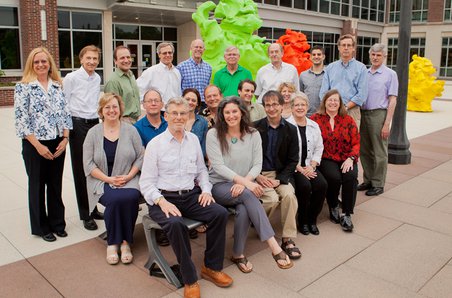
Members of the Executive Council at the May 29-30, 2014, in-person meeting hosted by the University of Illinois at Urbana-Champaign team.NAI Executive Council Meetings:
NAI Central plans and supports monthly executive council videocons, interspersed each year with three two-day in-person meetings — usually held at NAI Team sites. These meetings are designed to share current research results among teams, provide scientific input to NAI leadership, provide a forum for engaging the NAI international partners, and conduct other business of the NAI Executive Council. During this reporting period, in-person meetings and lab tours were held at the Jet Propulsion Laboratory in Pasadena, California, the University of Washington in Seattle, Washington, the University of Illinois at Urbana-Champaign, and the University of Southern California, in Los Angeles.
https://astrobiology.nasa.gov/nai/executive-council/NASA Astrobiology Newsletter:
The NASA Astrobiology Newsletter is published every 4-6 weeks providing information about astrobiology news, research highlights, events, funding, and career opportunities. During this reporting period a data clean-up was done to the mailing list of ~4850 as a new professional web emailing tool was implemented to allow the NAI and the Astrobiology Program better analytics to improve communication effectiveness and outreach to both science communities and the public.NASA Astrobiology Program Minority Institution Research Support (MIRS) Program:
NAI Central solicited projects, recruited applicants and selected and funded four MIRS Fellows in 2014- Dr. Peter Abanda, Mid-South Community College, Host – Leslie Prufert-Bebout, NASA Ames Research Center, “Roles of Microbes in Metal Binding and Uptake in Complex Microbial Systems”.
- Dr. Marcus Alfred, Howard University, Host- Paul Butler, Carnegie Institution of Washington, “Searching for Terrestrial Worlds Around Nearby Stars”.
- Dr. Jean-Marie Dimandja, Spelman College, Host – George Cooper, NASA Ames Research Center, “Development of a Multi-Dimentional Gas Chromatography/Mass Spectrometry Method for the Analysis of Extractable Organics in Meteorites”.
- Dr. James Wachira, Morgan State University, Host- George Fox, University of Houston, “Modeling the Tertiary Structure of the Ribosomal Peptidyl Transferase Center (PTC)”.
These Fellows conducted research spanning exoplanets, astrochemistry and and origins of life topics. The Minority Institute Astrobiology Consortium, comprising mainly former MIRS Fellows, was reinvigorated with a new web page and jointly submitted two proposals to continue collaborative astrobiology research with their students.
Virtual Meetings and Event Support:
To support the community and foster communication and collaboration, NAI Central provided its technical infrastructure and expertise for a number of virtual events in addition to the regularly occurring NAI seminar series, Executive Council meetings and NAI team meetings during this reporting period. Some of the notable events that were produced by NAI Central’s Collaboration Team were the Planetary Science’s Division Virtual Townhall, over 30 Astrobiology Strategic Planning Webinars , the NASA/Astrobiology Library of Congress Symposium, the Second Kepler Science Conference, MEPAG meetings, Mars 2020, the NASA Office of the Chief Scientist’s Science Communication Workshops and a webcast from the field with researchers at Lassen Volcanic National Park.International
International Astrobiology Newsletter:
The International Astrobiology Newsletter (IAN) is a quarterly newsletter providing information about astrobiology events and opportunities, mostly outside the U.S., to the international astrobiology community. The distribution list was ~3850 during this period with the top ten readership in descending order being the United Kingdom, India, Canada, Germany, Spain, Japan, Brazil, Australia, France, and Italy.
Japan and Earth-Life Science Institute (ELSI):
The NAI initiated discussions this past year with the newly established Earth‐Life Science Institute (ELSI) in Japan. Based at the Tokyo Institute of Technology (Tokyo Tech), ELSI is one of 9 World Premier International (WPI) Research Centers created by the Japanese Ministry of Education, Culture, Sports, Science and Technology (MEXT). The mission of ELSI includes reaching out to the international science community; its affiliated researchers include many current and past astrobiologists associated with the NAI. Many areas of potential collaborations were identified, and discussions included ELSI’s participation in an organization that would pursue an international partnership with the NAI.Education and Public Outreach
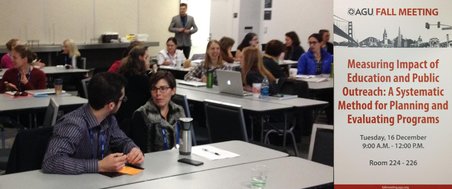
~40 education professionals from government and academia gathered at the 2014 AGU Fall Meeting for a 3-hour workshop led by Daniella Scalice and Hilarie Davis, Ed.D. on using the Quantitative Collaborative Impact Analysis Method to measure the impact of their projects, programs, and portfolios.External Evaluation of NAI Team Education and Public Outreach (EPO) Projects:
The development, validation, and deployment of the “Quantitative, Collaborative Impact Analysis Method” with NAI EPO project leads continued in FY 2014. The primary aim is to assess the impact of NAI EPO projects and programs on their participants. Impact data were gathered and preliminary results were presented at both the Astronomical Society of the Pacific and American Geophysical Union annual conferences.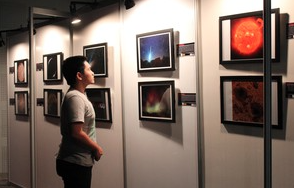
Each FETTSS exhibit is unique—curated and displayed according to each organization‘s goals and resources. A visitor enjoys the images at this FETTSS exhibit in Pasay City, Manila, The Philippines.From Earth to the Solar System:
From Earth to the Solar System (FETTSS) is a web-based collection of high resolution images hosted by NAI that showcase the discoveries and excitement of planetary exploration, with a focus on the origin and evolution of the Solar System and the search for life. Organizations across the globe access the collection to curate and display their own unique FETTSS exhibits. Initially developed for NASA’s Year of the Solar System campaign in 2011 – 2012, the collection remains available to interested parties, and NAI continues to receive requests for its exhibit which it provides to qualified applicants.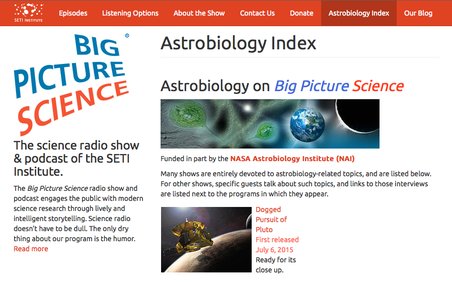
Astrobiology-related episodes of the Big Picture Science radio show produced by the SETI Institute are cataloged on their website.
The Astrobiology Walk at NASA’s Goddard Spaceflight Center.NAI EPO Supplemental Awards:
Awards were made in FY 2014 to several of NAI’s current and emeritus teams to support ongoing and de novo projects, including:- Astrobiology segments of SETI Institute’s Big Picture Science radio show (http://www.bigpicturescience.org)
- An astrobiology workshop for local teachers at the University of Illinois, Urbana-Champaign
- External evaluation of the Astrobiology Walk at NASA GSFC and the production of web content about the Walk for mobile devices
- Mini-teacher workshops conducted at various locations by alumni of the University of Hawaii’s Astrobiology Laboratory Institute for Instructors (ALI’I) program; external, longitudinal evaluation of the program
- Spanish-language marketing campaign and content/programming for the Astrobiology Summer Reading Program at Madison Public Libraries in Madison, WI
- Production by Montana State University of new, Yellowstone-related classroom lesson plans which are designed for use with the Next Generation Science Standards
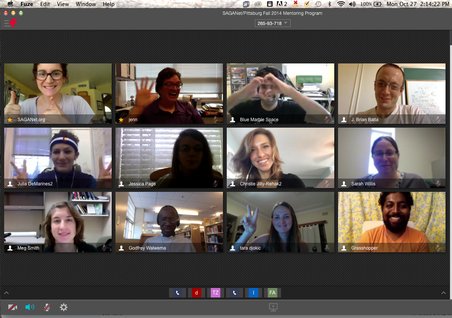
Screenshot of the kickoff meeting of SAGANet mentors as they prepare to engage students in the Pittsburg Community School Astrobiology Science Challenge.Pittsburg Community School Astrobiology Science Challenge:
NAI Central supported the implementation and evaluation of one of SAGANet’s eMentoring Programs wherein students in an at-risk school in San Francisco’s East Bay form small groups and are paired with a SAGANet mentor. Weekly communications between students and mentors result in final group presentations which are judged by FameLab alumni.UK Centre for Astrobiology’s Summer Student Academy: NAI Central supported travel for two US early career astrobiologists to join a summer camp for UK high school students sponsored by the UK Centre for Astrobiology. They served as camp counselors, instructors, and mentors to campers.
Recognition
Prizes/Awards:
The NAI joins in congratulating our members who have been the recipients of the following awards and honors:- Sean Solomon (CIW) received the nation’s top scientific honor, the National Medal of Science in 2014
- Ariel Anbar (ASU) Arizona State University’s first Howard Hughes Medical Institute Professor and President-Elect of the Biogeosciences Leadership at the American Geophysical Union for the 2015-2016 Term
- Jack Lissauer (ARC), NASA Ames Research Center’s H. Julian Allen Award
- Jordan Okie (ASU), American Naturalist 2014 Student Paper Award
- Nader Haghighipour (UH), Eric Agol (VPL) and Rory Barnes (VPL) papers were noted amongst the top 10 physics newsmakers in 2013, by the American Physical Society
- Moh El-Naggar (USC), 2014 Presidential Early Career Award for Scientists and Engineers